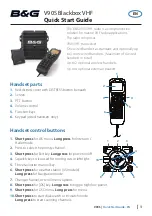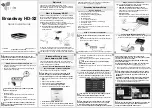
52
PROGRAMMING THE REMOTE
Programming the Remote
press the Command or Function key. Since we
want to program a series of events that occur
each time the Power On button is pressed,
press the AVR button. In your specific macro,
this is the first command button.
Figure 41
7. The next display (Figure 42) and the subse-
quent screens are where the actual macro
programming take place. The words at the left
side of the top line of the display show the
button that is being programmed (e.g., the
Power On Button
3
or one of the
Macro
Buttons
) and the indication at the right
side of the top line shows the number of
macro steps available of 20 possible steps.
Following the instructions on the remote’s
LCD screen, press the first key you wish to be
transmitted in the macro. In our example, we
first want the AVR to turn on, so the
Power
Button
3
should be pressed.
Figure 42
8. Once the first command button for the macro
has been pressed, continue to press the but-
tons you wish to be part of the macro, in the
order they will be used. Press each button
within five seconds of the last button, remem-
bering to press the
Input Selector
45
when you are changing device functions.
As the buttons on the remote are pressed,
the remote’s display screen will show the
steps in the macro as they are programmed
(Figure 43).
Figure 43
9. For our example, we first want the AVR Power
On button pressed, followed by the TV Power
On, followed by the Cable Box On, followed
by the selection of the Logic 7 mode. To do
that, press the buttons in this order:
• Power On
3
• VID 2/TV
4
• Power On
3
• VID 3/Cable
4
• Power On
3
• AVR
5
• Logic 7
O
As each button is pressed to enter it into the
macro you will see the button names appear
and then scroll up on the LCD display as your
confirmation of the key entry (Figure 43).
10. When all commands for the macro have
been entered, press the
Set Button
F
to
save the macro. The display screen will show
the button to which the macro has been pro-
grammed and the number of steps used, and
the word
SAVED
will blink four times in the
lower line of the LCD display. When the dis-
play returns to normal, the macro has been
entered and the remote is ready for opera-
tion.
11. If a macro has been programmed into the
Power On Button
3
, it will play back
anytime the Power On button is pressed. As
the macro plays, you will see the steps
appear in the remote’s LCD display. Macros
programmed into one of the four discrete
Macro buttons may be activated at any time
by pressing the appropriate button.
Erasing a Macro
Once a macro has been created and stored in
the AVR remote’s memory, you have the option
of erasing it. You may do this at any time by fol-
lowing these steps:
1. Press and hold the
Program Button
&
for
about three seconds while the message
shown in Figure 15 appears in the remote’s
LCD Information Display
2
. Release the
button when the red light under the
Set
Button
F
appears.
2. The remote’s
MAIN MENU
message (Figure
16), will appear in the LCD display and the
Set Button
F
will remain illuminated in
red. Press the
⁄
Navigation Buttons
E
three times so that
MACRO
appears on the
bottom line of the LCD screen, as shown in
Figure 37. Press the
Set Button
F
to enter
the main macro menu branch.
3. At the next menu screen (Figure 44) press
⁄¤
Navigation Buttons
E
until the
bottom line in the remote’s LCD display reads
ERASE A MACRO
, as shown in Figure 44.
Press the
Set Button
F
to begin the
process of erasing a macro.
Figure 44
4. The next display screen (Figure 45) is where
you select which macro will be erased. Press
the
⁄¤
Navigation Buttons
E
until the
number of the macro you wish to erase
appears. For this example we will erase the
Power On macro created in the previous sec-
tion. When the name of the macro to be
erased appears, press the
Set Button
F
.
Figure 45
5. The word
ERASED
will flash four times in the
bottom line of the remote’s LCD display, and
then the display will return to its normal con-
dition. When that happens the macro is
erased and the remote is returned to normal
operation.
Read a Macro
To check the commands stored in the remote’s
memory for one of the buttons, follow these
steps:
1. Press and hold the
Program Button
&
for
about three seconds while the message
shown in Figure 15 appears in the remote’s
LCD Information Display
2
. Release the
button when the red light under the
Set
Button
F
appears.
2. The remote’s
MAIN MENU
message (Figure
16), will appear in the LCD display and the
Set Button
F
will remain illuminated in
red. Press the
⁄
Navigation Buttons
E
three times so that
MACRO
appears on the
bottom line of the LCD screen, as shown in
Figure 37. Press the
Set Button
F
to enter
the main macro menu branch.
3. At the next menu screen (Figure 46) press the
⁄¤
Navigation Buttons
E
until the
bottom line in the remote’s LCD display shows
READ A MACRO
, as shown in Figure 46.
Press the
Set Button
F
to begin the
process of erasing a macro.
Figure 46
4. The next display screen (Figure 47) is where
you select the macro to be read. Press the
⁄¤
Navigation Buttons
E
until the
name of the macro you wish to read appears.
For this example, we will read back the Power
On macro created in the previous section.
When the name of the macro to be erased
appears, press the
Set Button
F
.
Figure 47
5. As soon as the Set button is pressed, the first
two steps in the macro will be appear in the
remote’s LCD screen. You may then use the
⁄¤
Navigation Buttons
E
to step up
or down through the list of commands stored
as the macro. As you read the display, you will
see
Device Selector Buttons
45
appear in brackets, (e.g.,
[AVR]
). When the
step in the macro is a function, navigation or
any other button, it will appear next to the
bracketed read-out of the underlying device
(e.g.,
[AVR] POWER ON
).
6. When you are finished reviewing the macro’s
contents, press the
Set Button
F
to return
the remote to normal operation.
Punch-Through Configuration
Punch-through is a capability of the remote that
allows the Volume controls, Channel Up/Down
buttons or Transport keys (Play, Stop, Record,
Fast Forward and Reverse, and Skip Up/Down) to
link to a different device. For example, if your TV,
R E A D A M A C R O
P O W E R O N
M A C R O
R E A D A M A C R O
E R A S E A M A C R O
P O W E R O N
M A C R O
E R A S E A M A C R O
[ A V R ]
[ A V R ] P O W E R O N
P O W E R O N 0 0 / 2 0
S E L E C T K E Y P R E S S
S E L E C T A D E V I C E
A V R











































